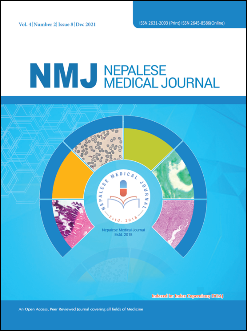Histopathological Study of Endometrial Changes in Hysterectomy Specimens with Cystic Lesion of Ovary
DOI:
https://doi.org/10.3126/nmj.v4i2.41661Keywords:
Cystic lesions; Endometrial hyperplasia; OvaryAbstract
Introduction: Some of the ovarian lesions become functional and secrete hormones that bring endometrial changes like hyperplasias and polyps. This study aimed to find endometrial changes associated with different types of cystic lesions of the ovary.
Materials and Methods: A histopathological study done from 2010 -2013 on all the total abdominal hysterectomy specimens with bilateral oophorectomy having cyst size more than 3cms, with a detailed clinical history received in the Department of Pathology, Sri Manakula Vinayagar Medical College and Hospital, Pondicherry. A total of 112 cases were collected analyzed and statistically correlated.
Results: Out of the 112 cases of cystic lesions of the ovary 67% showed endometrium within normal limits, 33% of cystic lesions of ovary showed polyps, simple hyperplasia without atypia, complex hyperplasia without atypia. Among non-neoplastic lesions, follicular cyst produced the most endometrial changes, followed by benign surface epithelial lesions. Granulosa cell tumor was found to induce polyp as well as simple hyperplasia without atypia. Two out of three malignant lesions showed endometrial changes followed by benign lesions. The majority of the cystic lesions of the ovary encountered are non-neoplastic lesions (59%) and follicular cysts were more common (97%). Endometrial hyperplasia of both simple and complex types without atypia was found with serous cystadenoma.
Conclusions: From the current study it implicates the necessity of assessing cystic lesions of the ovary like a follicular cyst, luteal cyst, granulosa cell tumors as they can become functional leading to endometrial changes that can form a fertile ground for carcinomas.
Downloads
Downloads
Published
How to Cite
Issue
Section
License
Copyright (c) 2022 Parvathi Pillai

This work is licensed under a Creative Commons Attribution 4.0 International License.
This license enables reusers to distribute, remix, adapt, and build upon the material in any medium or format, so long as attribution is given to the creator. The license allows for commercial use.
Copyright on any article published by Nepalese Medical Journal is retained by the author(s).
Authors grant Nepalese Medical Journal a license to publish the article and identify itself as the original publisher.
Authors also grant any third party the right to use the article freely as long as its integrity is maintained and its original authors, citation details and publisher are identified.




